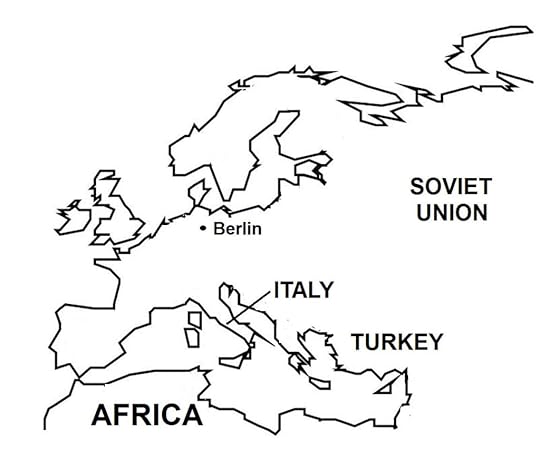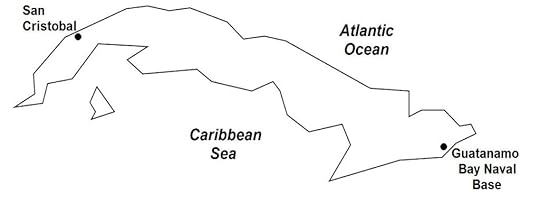July 8, 1960 – Cold War: U-2 pilot Francis Gary Powers is charged for espionage by the Soviet Union
On May 1, 1960, a United States U-2 spy plane piloted byFrancis Gary Powers was shot over Soviet airspace by a Russian surface-to-airmissile. Power’s mission, directed bythe U.S. Central Intelligence Agency (CIA), was to take surveillancephotographs on an overflight over central Russiafrom a base in Pakistan toanother base in Norway.
Powers survived by parachuting to the ground where he was arrested by Soviet authorities. The U.S. government of President Dwight D. Eisenhower initially stated that the plane was on a NASA research mission but later admitted that the U-2 was conducting surveillance of Russian territory after the Soviet government produced the captured pilot and evidence of the plane’s wreckage, and more important, the intact surveillance equipment and photographs of Soviet military installations taken during the flight.
Subsequently, Powers was convicted of espionage andsentenced to ten years imprisonment. Hedid not serve the full sentence but was released in February 1962 on a prisonerexchange “spy swap” agreement between the American and Soviet governments.
Following the 1960 incident, the United States made changes to policy, procedures, and protocols regarding surveillance and reconnaissance missions. Subsequently, the U-2 was used in overflight missions in Cuba when in August 1962, the first evidence of the presence of Soviet nuclear-capable surface-to-air missile (SAM) sites were detected on the island, sparking the Cuban Missile Crisis.
 NATO’s deployment of nuclear missiles in Turkey and Italy was a major factor in the Soviet Union’s decision to install nuclear weapons in Cuba.
NATO’s deployment of nuclear missiles in Turkey and Italy was a major factor in the Soviet Union’s decision to install nuclear weapons in Cuba.(Excerpts taken from Wars of the 20th Century – Volume 2)
Background of the Cuban Missile Crisis After the unsuccessful Bay of Pigs Invasion in April 1961 (previous article), the United States government under President John F. Kennedy focused on clandestine methods to oust or kill Cuban leader Fidel Castro and/or overthrow Cuba’s communist government. In November 1961, a U.S. covert operation code-named Mongoose was prepared, which aimed at destabilizing Cuba’s political and economic infrastructures through various means, including espionage, sabotage, embargos, and psychological warfare. Starting in March 1962, anti-Castro Cuban exiles in Florida, supported by American operatives, penetrated Cuba undetected and carried out attacks against farmlands and agricultural facilities, oil depots and refineries, and public infrastructures, as well as Cuban ships and foreign vessels operating inside Cuban maritime waters. These actions, together with the United States Armed Forces’ carrying out military exercises in U.S.-friendly Caribbean countries, made Castro believe that the United States was preparing another invasion of Cuba.
From the time he seized power in Cubain 1959, Castro had increased the size and strength of his armed forces withweapons provided by the Soviet Union. In Moscow,Soviet Premier Nikita Khrushchev also believed that an American invasion wasimminent, and increased Russian advisers, troops, and weapons to Cuba. Castro’s revolution had provided communismwith a toehold in the Western Hemisphere andPremier Khrushchev was determined not to lose this invaluable asset. At the same time, the Soviet leader began toface a security crisis of his own when the United States under the North Atlantic Treaty Organization(NATO) installed 300 Jupiter nuclear missiles in Italyin 1961 and 150 missiles in Turkey(Map 33) in April 1962.
In the nuclear arms race between the two superpowers, the United States held a decisive edge over the Soviet Union, both in terms of the number of nuclearmissiles (27,000 to 3,600) and in the reliability of the systems required todeliver these weapons. The Americanadvantage was even more pronounced in long-range missiles, called ICBMs(Intercontinental Ballistic Missiles), where the Soviets possessed perhaps nomore than a dozen missiles with a poor delivery system in contrast to the United States that had about 170, which whenlaunched from the U.S.mainland could accurately hit specific targets in the Soviet Union.
The Soviet nuclear weapons technology had been focused onthe more likely war in Europe and therefore consisted of shorter rangemissiles, the MRBMs (medium-range ballistic missiles) and IRBMs(intermediate-range ballistic missiles), both of which if installed in Cuba,which was located only 100 miles from southeastern United States, could targetportions of the contiguous 48 U.S. States. In one stroke, such a deployment would serve Castro as a powerful deterrentagainst an American invasion; for the Soviets, they would have invoked theirprerogative to install nuclear weapons in a friendly country, just as theAmericans had done in Europe. More important, the presence of Sovietnuclear weapons in the Western Hemisphere would radically alter the globalnuclear weapons paradigm by posing as a direct threat to the United States.
In April 1962, Premier Khrushchev conceived of such a plan,and felt that the United States would respond to it with no more thana diplomatic protest, and certainly would not take military action. Furthermore, Premier Khrushchev believed thatPresident Kennedy was weak and indecisive, primarily because of the Americanpresident’s half-hearted decisions during the failed Bay of Pigs Invasion inApril 1961, and President Kennedy’s weak response to the East German-Sovietbuilding of the Berlin Wall in August 1961.
A Soviet delegation sent to Cuba met with Fidel Castro, whogave his consent to Khrushchev’s proposal. Subsequently in July 1962, Cubaand the Soviet Union signed an agreementpertinent to the nuclear arms deployment. The planning and implementation of the project was done in utmostsecrecy, with only a few of the top Soviet and Cuban officials being informed. In Cuba, Soviet technical and militaryteams secretly identified the locations for the nuclear missile sites.
 In October 1962, an American U-2 spy plane detected a Soviet nuclear missile site under construction in San Cristobal, Pinar del Rio. After the Cuban Missile Crisis, the continued presence of the Guantanamo Bay Naval Base, a U.S. military facility located at the eastern end of Cuba, greatly infuriated Cuban leader Fidel Castro.
In October 1962, an American U-2 spy plane detected a Soviet nuclear missile site under construction in San Cristobal, Pinar del Rio. After the Cuban Missile Crisis, the continued presence of the Guantanamo Bay Naval Base, a U.S. military facility located at the eastern end of Cuba, greatly infuriated Cuban leader Fidel Castro.In August 1962, U.S.reconnaissance flights over Cubadetected the presence of powerful Soviet aircraft: 39 MiG-21 fighter aircraftand 22 nuclear weapons-capable Ilyushin Il-28 light bombers. More disturbing was the discovery of the S-75Dvina surface-to-air missile batteries, which were known to be contingent tothe deployment of nuclear missiles. Bylate August, the U.S.government and Congress had raised the possibility that the Soviets wereintroducing nuclear missiles in Cuba.
By mid-September, the nuclear missiles had reached Cubaby Soviet vessels that also carried regular cargoes of conventionalweapons. About 40,000 Soviet soldiersposing as tourists also arrived to form part of Cuba’sdefense for the missiles and against a U.S. invasion. By October 1962, the Soviet Armed Forces in Cubapossessed 1,300 artillery pieces, 700 regular anti-aircraft guns, 350 tanks,and 150 planes.
The process of transporting the missiles overland from Cubanports to their designated launching sites required using very large trucks,which consequently were spotted by the local residents because the oversizedtransports, with their loads of canvas-draped long cylindrical objects, hadgreat difficulty maneuvering through Cuban roads. Reports of these sightings soon reached theCuban exiles in Miami, and through them, the U.S.government.



